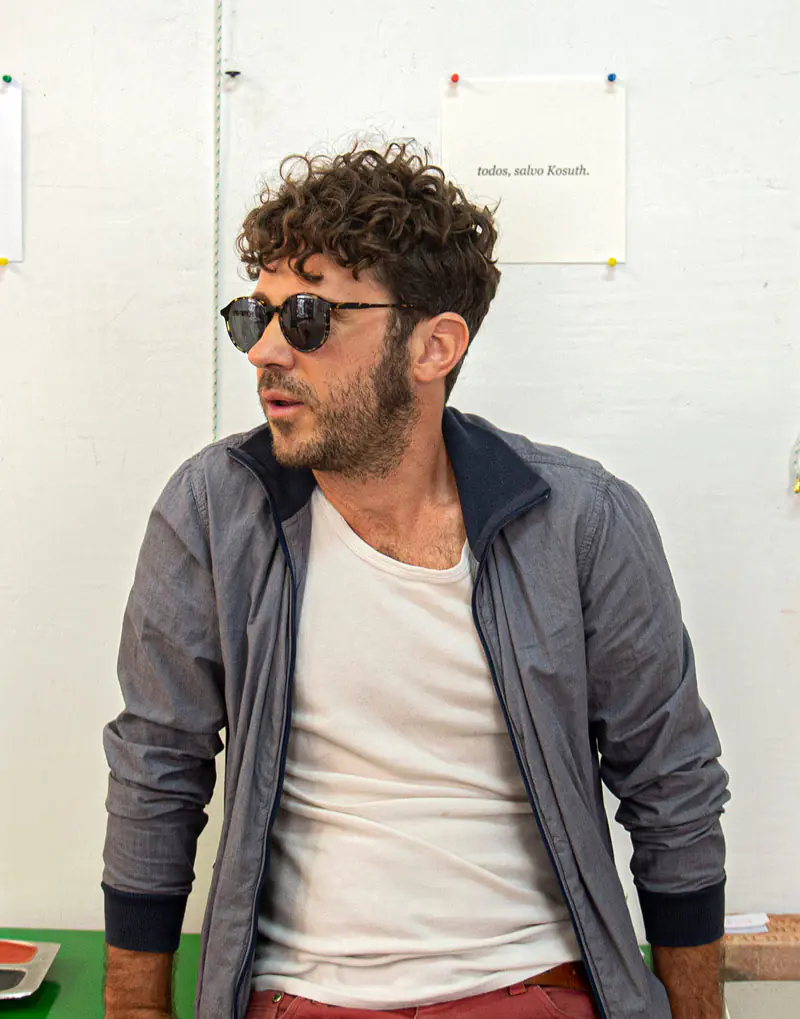ABOUT

En líneas generales mi obra surge de una respuesta al entorno más cercano en distintos niveles, ya sea material, conceptual o lingüístico.
En una cultura material hiper-desarrollada me interesa la variedad de narrativas posibles que se derivan del espesor semántico del objeto. En este sentido mi obra busca proponer una gramática formal que expanda el ciclo funcional del objeto y permita pensar la cosa misma más allá de los preceptos de lo dado.
La materialidad del objeto es otro plano presente en mi trabajo. Su realidad perteneciente a un orden pre-simbólico me permite transitar los límites categoriales del objeto y probar posibles disoluciones formales. Con el fin de cifrar aquello que solo la experiencia y los procesos arrojan, me sirvo de algunos parámetros abiertos como el gesto, el accidente o el registro.
Uso para mis obras la pequeña escala que toma al objeto como modelo referencial histórico. En este sentido mi trabajo se vincula a un tipo de escultura no monumental, que, si bien tiene una razón política y estética de base, también responde a cuestiones logísticas de espacio y financiación.
En relación al actual contexto histórico de colapso ambiental me gusta reflejar en mi obra la tensión que postula el objeto en calidad de cuerpo entrópico, como una forma de tomar conciencia material del mundo. En este sentido, me interesa también el recurso narrativo que ofrece la distopía y sus posibles simulacros formales.
Así mismo, a la luz del paradigma digital, trabajo a través del objeto en torno a la categoría del Aquí, como una dimensión resistente disociada del Ahora, donde la cosa permanece en forma de resto y soporte cadáver.
In general terms, it is a reaction towards the immediate surroundings – whether a material, a concept or a word – that serves as a spark for my work.
Within a hyper-developed material culture, what I find most appealing is the variety of possible narratives that stem from the semantic load of an object. Along these lines, my work aims at suggesting a conceptual grammar which lengthens the functional lifespan of an item, thus allowing the recipient to reflect upon the object itself even beyond a pre-established framework.
The material nature of objects is also approached by my work. The fact that they belong to a pre-symbolic category lets me explore their limits as physical entities and try possible deviations from their original form. With the aim of creating a code for sensory events derived from experience and processes, I use a few open parameters
such as gesture, accident or register.
By taking the object as a model of historical reference, my work is linked to a type of non-monumental sculpture which not only has political and aesthetic principles at its core but also tries to solve logistics, space and funding issues.
As a response to the current historical context of environmental collapse, I indulge in rendering the tension between an object’s entropy and external chaos in an attempt to become aware of the physical world. Therefore, dystopia as well as its possible formal interpretations is another narrative technique I resort to.
Likewise, the digital era has given me the opportunity to work on the object as a category of the ‘Here’ dissociated from the ‘Now’, where items seem to exist as remains or material corpses.
LUIS DOMERCQ MUÑOZ (MRCQ)
Madrid, 1982. Vive y trabaja en un pueblo de Madrid
FORMACIÓN
2009 Licenciado en Bellas Artes. Universidad Complutense de Madrid
INDIVIDUALES
2024 Objetografico. Amazink Print Studio, Madrid
2022 Mancha tipográfica. Espacio marcablanca, Madrid
COLECTIVAS
2021 Hybrid Art Fair. Cadmium Gallery, Madrid
2020 Hybrid Art Fair. Cadmium Gallery, Madrid
2019 Artistas del Barrio. Estudio Moratón Mendoza, Madrid
2018 Artistas del Barrio. Estudio Moratón Mendoza, Madrid
2017 Nudo 17: Muestra de poesía visual. Espacio NIU, Barcelona
2008 Moncloa Centro y Periferia. Centro Cultural Moncloa, Madrid
2006 Jardín del Paraíso. Galería El Ojo Atómico, Madrid
AUTOEDICIÓN
2025 La Liada Gráfica. MRCQ, Alicante
2024 MiraLookBooks. Escrito a Lápiz, Madrid
2024 Indómitas (FLM). Escrito a Lápiz, Madrid
2023 Bala. Escrito a Lápiz, Bilbao
2023 Turbo. Espacio Tyce, Guadalajara
OTROS ESTUDIOS
2021 Taller de extracción de pigmentos orgánicos. Estudio Alicia Mediavilla, Segovia
2021 Orientación profesional para artistas visuales. Asoc. Arte Sostenible, Barcelona
2020 Taller de pigmentos. Espacio Aletheia, Madrid
2015 Taller de torno en cerámica. Estudio Miguel Molet, Huesca